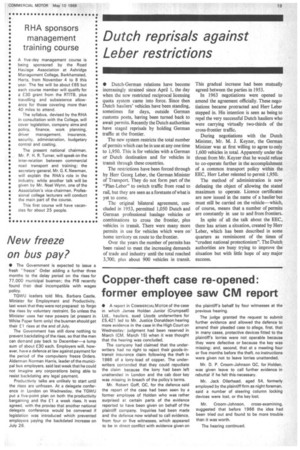Dutch reprisals against Leber restrictions
Page 21

If you've noticed an error in this article please click here to report it so we can fix it.
• Dutch-German relations have become increasingly strained since April 1, the day when the new restricted reciprocal licensing quota system came into force. Since then Dutch hauliers' vehicles have been standing, sometimes for days, outside German customs posts, having been turned back to await permits. Recently the Dutch authorities have staged reprisals by holding German traffic at the frontier.
The new system restricts the total number of permits which can be in use at any one time to 1,950. This is for vehicles with a German or Dutch destination and for vehicles in transit through these countries.
The restrictions have been forced through by Herr Georg Leber, the German Minister of Transport. They do not form part of the "Plan-Leber" to switch traffic from road to rail, but they are seen as a foretaste of what is yet to come.
The original bilateral agreement, concluded in 1953, permitted 1,050 Dutch and German professional haulage vehicles or combinations to cross the frontier, plus vehicles in transit. There were many more permits in use for vehicles which were on ' home territory en route to the frontier.
Over the years the number of permits has been raised to meet the increasing demands of trade and industry until the total reached 3,700, plus about 900 vehicles in transit. This gradual increase had been mutually agreed between the parties in 1953.
In 1963 negotiations were opened to amend the agreement officially. These negotiations became protracted and Herr Leber stepped in. His intention is seen as being to repel the very successful Dutch hauliers who were carrying virtually two-thirds of the cross-frontier traffic.
During negotiations with the Dutch Minister, Mr. M. J. Keyzer, the German Minister was at first willing to agree to only 1,600 vehicles in total. Apparently under the threat from Mr. Keyzer that he would refuse to co-operate further in the accomplishment of a common transport policy within the EEC, Herr Leber relented to permit 1,950.
The method of administration is now defeating the object of allowing the stated maximum to operate. Licence certificates are now issued in the name of a haulier but must still be carried on the vehicle—which, of course, means that a number of permits are constantly in use to and from frontiers.
In spite of all the talk about the EEC, there has arisen a situation, created by Herr Leber, which has been described in some quarters as reminiscent of the times of "crudest national protectionism". The Dutch. authorities are busy trying to improve the situation but with little hope of any major
SUCCESS.












































































































